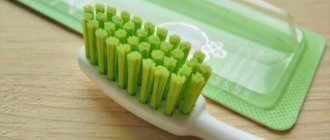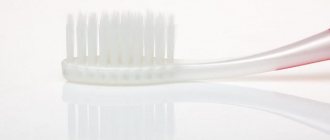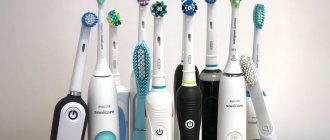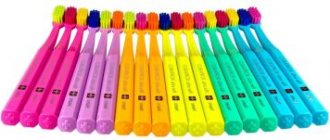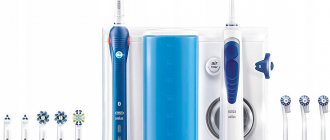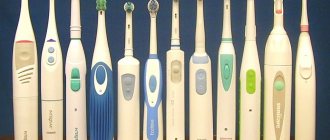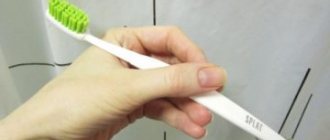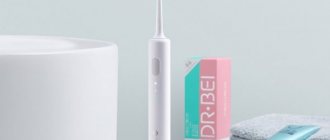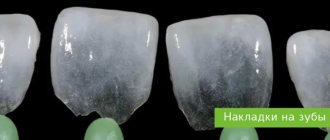Many people buy toothbrushes without thinking about their technical characteristics and based only on price. However, they differ in many parameters: the material and stiffness of the bristles, the shape and size of the head, etc. To choose the right toothbrush, you should take into account as many criteria as possible. Let's tell you more about them.
In this article
- Which toothbrush to choose
- What shape and size should a toothbrush be?
- How to choose a toothbrush based on bristle material
- What toothbrush is best?
- Which toothbrush to choose - soft or hard?
- How to choose a brush based on the shape of the bristles
- Additional functions of toothbrushes
- Hardness of electric toothbrushes
- Which toothbrush to buy
- How often to change the brush
- How to care for your brush
When buying a toothbrush, do we think about the stiffness of the bristles, the size of the head, the material and its other parameters? As a rule, we choose them based on external data, based on the fact that one model is suitable for adults, the other for children. However, the quality of cleaning the oral cavity depends on a properly selected toothbrush. If it is not suitable for medical parameters and individual anatomical features, it cannot be used, as there is a risk of damage to the gums and enamel. In addition, brushing your teeth with such a brush will simply be inconvenient.
Understanding this issue is not so difficult. There are several criteria that will help you choose the right toothbrush.
What shape and size should a toothbrush be?
Toothbrushes are available in different sizes and head shapes. Please note the following features:
- The head should cover a maximum of 2-2.5 teeth. Only in this case will cleaning be effective. The head is too large and does not allow the bristles to penetrate into the interdental spaces.
- The length of the toothbrush head for children should be 18-25 mm, and for adults - 30 mm maximum. The child’s teeth are just growing, the jaw is not yet formed, so the large head can injure the gums. Small brushes are not useless for an adult, but brushing teeth with them is inconvenient. In addition, you will have to spend a lot of time on the procedure.
- The head should have a rounded shape to minimize the risk of injury to the oral mucosa.
- The area connecting the head with the handle must be movable so that the spring effect is triggered, due to which the pressure on the teeth and gums is reduced. Almost all modern brushes have a flexible neck to control pressure.
Brushes differ in the number of tufts. The larger the head, the more bristles it is equipped with. Children under 6 years old need to choose models with 23 bundles, teenagers - with 30-40, adults - with 45-55 bundles. People with braces should have a multi-tuft brush (more than 55). Their number is indicated on the packaging. It is not always possible to quickly find this parameter among the information written in small print. However, the quality of teeth cleaning depends on this, so it is better not to ignore this feature of the brush.
As for the handle, it just needs to be comfortable. It is advisable to choose a model with a rubberized coating that will not slip out of your hand.
Characteristics of bristles
Natural or artificial bristles - what to choose?
Currently, the production of natural bristle bristles is kept to a minimum for several reasons:
- The rigidity is usually high.
- The tip of the bristles cannot be rounded (cannot be processed), it is traumatic for the mucous membrane, and easily flakes.
- There is a small cavity inside the natural bristles, due to which they absorb moisture and promote the proliferation of harmful microorganisms in the oral cavity.
- Surface with burrs, porous.
- Devices made from natural materials quickly become unusable due to fragility and abrasion of the bristles.
Toothbrush bristles were traditionally made from hog bristles. Natural bristles, due to certain disadvantages, limited and reduced the possibilities for developing more advanced toothbrushes. Currently, technology has been developed for rounding, grinding and polishing the tips of each artificial bristle. Due to the undeniable advantage of artificial fiber for the manufacture of toothbrushes, the production of brushes with natural bristles is kept to a minimum.
The ideal choice would be a tool made of synthetic fibers (usually nylon).
Bristle hardness
The bristles of toothbrushes can be of different thickness (which largely determines their rigidity), mobility, and with differently processed tips. The optimal bristle height is 10-12mm.
The most important parameter for classifying toothbrushes is the stiffness of the bristles. However, this indicator is not standardized and there is no single criterion for the stiffness of the bristles. Some manufacturers distinguish 5 degrees of hardness:
- Very tough
- tough,
- medium hardness (nylon bristles with fiber diameter up to 0.22 mm),
- soft (nylon bristles with fiber diameter up to 0.2 mm),
- very soft (nylon bristles with a fiber diameter of 0.15 - 0.18 mm).
Manufacturers sometimes use fibers of different diameters in brushes, but at the same time indicate the same degree of hardness.
Soft brushes are intended for cleaning temporary teeth, teeth with weakly mineralized enamel, as well as for inflammatory diseases of the periodontium and oral mucosa in order to avoid injury. Hard bristles should be used when the enamel is mature and there is a tendency to increased formation of mineralized and non-mineralized dental plaque.
Many modern brushes combine bristles of different hardness:
- central, stiffer bristles are designed to effectively clean the chewing surfaces of teeth (they are often shorter),
- peripheral softer (usually longer) bristles are less traumatic, clean the gingival groove, penetrating quite deeply into it (Junior Blend-a-dent, Medic Blend-a-dent, Colgate Plus brushes).
You can often see that bristles of different degrees of hardness are marked with different colors.
Artificial bristle tips
In modern toothbrushes they are rounded, which increases their polishing ability and prevents injury to periodontal tissue and the oral mucosa. The tips of the bristles can be:
- Rounded ones scratch the gum least of all;
- Pointed ones - better clean teeth and the spaces between them;
- Blunt - massages the gums well.
Cleaning heads
Toothbrushes are made with cleaning heads of different sizes and shapes. Products with rounded and rounded corners are considered less traumatic for the mucous membrane.
The cleanliness of the tooth surface depends on the width of the head. Its length is usually no more than 30 mm. The small size allows the brush not to injure the teeth or mucous membranes of the opposite side of the mouth during cleaning.
The area of the brush head affects the number of tufts of bristles located on it:
- instruments for adults have from 47 to 55 tufts;
- There are 23 tufts on children's brushes;
- devices for teenagers are produced with 39 beams.
Mono-beam products are also worth mentioning. With just one beam, they help maintain the cleanliness of the oral cavity with orthodontic systems and irregularities in the dentition.
Micro-textured bristles for toothbrushes
The ORAL-B company has developed microtextured bristles for toothbrushes . New patented technology increases the texture of each bristle by applying a polymer coating to each nylon bristle.
These bristles are designed to more effectively clean the surface of teeth not only with the tips of the brush, but also with their side surfaces. The microtexture is located throughout the surface of the brush, but it is so small that it can only be discerned using an electron scanning or atomic microscope. Its size and shape matches the microtexture of the surface layers of enamel, which further increases the cleaning effectiveness of the toothbrush.
Brushes with silicone lugs
New developments include brushes with silicone ridges instead of nylon bristles, and with a soft synthetic elastomer plate built into the head to scrape away plaque and the surface of the tooth (Signal).
With use, the bristles of the toothbrush wear out - the bristles fall out, become loose, lose shape, bushiness, and shorten the bristles. Such changes make the brush unsuitable for further use and require its replacement. The brush should be replaced at least once every three months, although many authors recommend even more frequent replacement. However, the rate of wear of a brush can vary significantly depending on the force of pressure on it, frequency of use, toothpastes and powders used, and individual characteristics of the structure of the dentition. For example, it has been determined that for effective cleaning, the pressure on the toothbrush should be 60-80g; Some hygienists recommend that their clients test this pressure by applying pressure to a postal scale with a brush.
Use of CUREN® polyester fibers in CURAPROX brushes
If the bristles of the brush are soft, then it will not cause any harm. If, in addition, the bristles are thin, then the grooves of the teeth are easily accessible, and such a brush carefully eliminates harmful bacteria. This is important, since especially many bacteria accumulate in inaccessible places that can be easily damaged.
The CURAPROX CS 5460 ultra soft toothbrush meets all these criteria. The bristles of such a brush, or bristles, as they are also called, are so thin that it easily penetrates into the grooves, which are serious spaces between the teeth and gums, and cleans gently without causing damage. CURAPROX toothbrushes use CUREN® polyester fibers. CUREN ® fibers absorb significantly less moisture than nylon, which is used as bristles in various other standard toothbrushes. CUREN ® fibers remain strong even when wet, the bristles of the toothbrush do not deform and retain their shape for a long time.
Dense bristles that gently clean the tooth surface.
These 5,460 bristles, with an unusually high number of fibers, are tightly packed onto the compact head of the toothbrush. This guarantees a high level of efficiency: each movement of the CURAPROX CS 5460 ultra soft brush when brushing your teeth removes much more plaque than hard toothbrushes with widely spaced bristles and harmful plastic inserts that create the illusion of volume.
If this is accompanied by the correct brushing technique, then everything is done correctly and usefully for excellent oral health!
Fiber bundle arrangement
In the brush head, the bristles are organized into tufts, which are usually arranged in 3 or 4 rows. This arrangement allows for better cleaning of all surfaces of the teeth.
As a rule, the tufts of bristles have different heights: longer (softer) along the periphery, shorter ones in the center.
Each group of beams contributes to a more thorough removal of plaque in a particular area of the dentition. Straight tall fibers clean plaque in the interdental spaces, and short fibers clean plaque in fissures. Bundles of fibers located in an oblique direction, penetrating into the periodontal sulcus, remove plaque from the cervical area.
Toothbrushes with V-shaped fiber bundles are recommended for cleaning plaque from the contact surfaces of teeth in those who have wide interdental spaces.
Some toothbrush models have a power projection for better cleaning of the molar, especially the distal surfaces of the last molar and deep penetration into the interdental spaces.
Often toothbrushes have an indicator - two rows of tufts of fibers colored with different colored food dyes that fade with use. The signal to replace the brush is when the bristles become discolored by half their height. This usually occurs after 2-3 months with brushing your teeth twice daily.
How to choose a toothbrush based on bristle material
Today, products made from natural materials are popular. Some people also prefer to buy toothbrushes with natural bristles, such as pig bristles.
However, dentists claim that it is better to abandon this idea for the following reasons:
- In bristles made from natural material, microorganisms multiply twice as fast. You will have to change such a brush more often - almost every month.
- The tips of pig bristles cannot be made rounded, so they can be traumatic. These brushes are not suitable for those with sensitive gums. It is also better not to buy them for children.
- Natural bristles quickly become shaggy: the hairs soften, flake and spread to the sides. The brush loses its shape and functionality. You won't be able to brush your teeth properly with it. In addition, the soft tissue of the oral cavity can be damaged by the plastic head.
Dentists advise choosing toothbrushes with nylon bristles and a safe plastic handle. It is safe for teeth, suitable for almost everyone and easier to dispose of without harming the environment. Now we’ll find out which toothbrush hardness is best to choose.
Indications for using a soft bristle brush
This hygiene item is not suitable for everyone, and in some cases it does not fully do its job.
It is worth noting! Soft dental appliances are ideal for:
- babies learning to care for their first teeth;
- children during the period of replacement of milk teeth with permanent ones (10-12 years);
- people with poor blood clotting (diabetics);
- adults with sensitive, easily damaged enamel ;
- people with various oral diseases (periodontitis, gingivitis, stomatitis, periodontal disease);
- patients with tooth mobility syndrome.
Also, a soft toothbrush is ideal for adults with a history of erosive lesions or wedge-shaped defect .
Dentists recommend buying soft toothbrushes for children under 10 years of age.
This is due to the imperfection of dental tissues and the vulnerability of the mucous membrane.
Hard fibers can cause damage, leading to more serious consequences.
For older people, a soft-bristle toothbrush is ideal..
Know! Over time, the body wears out, and this directly affects the gums: they become loose and bleed at the slightest damage.
What toothbrush is best?
Toothbrushes are divided into the following types according to the stiffness of the bristles:
- Very soft. An excellent option for those with bleeding gums, patients after dental surgery, diabetics and pregnant women. The risk of injury to soft tissues, even if they are vulnerable, is practically absent.
- Medium hardness. Suitable for all people with a healthy oral cavity. Most brushes on the market fall into this category.
- Tough. Used temporarily to remove plaque caused by smoking or frequent drinking of coffee and tea. Constantly using a hard brush is harmful: you can damage the enamel or gums.
- Very tough. Prescribed by a doctor when installing orthodontic structures. It is not recommended to purchase such brushes without the approval of a dentist.
What toothbrush hardness is best for you depends on your medical indications. Let us describe in more detail the features of soft and hard bristles.
Is it possible to damage tooth enamel?
The main danger of using a hard brush is that it can damage the enamel . As a result, users will experience a reaction to eating cold or hot food .
In addition, hard fibers can have a negative effect on the gums.
Need to know! Products with such bristles should be purchased carefully and only after consultation with a dentist.
If, after an examination at a dental clinic, the doctor advises you to choose a model with hard bristles, then it will effectively cleanse your teeth of plaque, preventing various diseases in the oral cavity.
Which toothbrush to choose - soft or hard?
A soft brush gently removes food debris and plaque without causing any strong impact on the tissue. They are indicated for use in the following cases:
- age up to 12 years;
- increased gum sensitivity;
- abrasion of tooth enamel;
- diabetes;
- blood clotting problem;
- tooth mobility;
- pregnancy;
- a number of periodontal diseases.
However, such a brush is useless for smokers, coffee drinkers, and teeth that are prone to plaque formation. Also, soft bristles do not allow you to clean the interdental spaces if they are too small. In these cases, it is better to choose a toothbrush with stiffer bristles. It has several undeniable advantages:
- removes plaque and surface deposits on teeth and gums;
- better cleanses the interdental spaces from food debris and germs;
- prevents darkening of enamel when drinking coffee and smoking;
- allows for better cleaning of orthodontic structures.
The downside of a hard brush is the presence of contraindications to its use, including abrasion of enamel, sensitivity of the gums and poor blood clotting.
The types of bristle hardness are as follows:
- Very soft (approx. - ultrasoft, extrasoft, sensitive). Suitable for children under 5 years of age and for adults with very sensitive enamel and gums, stage 1-2 periodontitis, and enamel damage.
- Soft (approx. - soft). Indicated for expectant and nursing mothers, children aged 5-12 years, as well as for diabetes and bleeding gums.
- Average (approx. - medium). The most popular brush for healthy enamel and oral cavity for adults and children over 12 years old.
- Hard and very hard (approx. – hard, extra-hard). An option for adults who are familiar firsthand with the rapid formation of plaque. And also for people using braces and other orthodontic structures.
And now a little about the material from which the brushes are made.
No matter how popular the idea that everything and everywhere is natural, dentists categorically do not recommend brushes with natural bristles.
How to choose a brush based on the shape of the bristles
The bristles of a toothbrush can be single-level, two-level, three-level and multi-level. Research shows that multiple levels of bristles provide better cleaning between teeth and gum pockets.
Based on the arrangement of the beams, three types of brushes are distinguished:
- Hygienic: with even and straight bundles of the same length. This is a very ordinary brush with minimal functionality. Usually such models are bought for children.
- Preventive: the beams are located in different directions, have different lengths and even rigidity. There may be rubber bristles on the sides of the brush that massage the gums while brushing your teeth.
- Special: designed for cleaning braces, implants and other structures. Such brushes are sold in pharmacies and can be made to order. It is better to buy them after consulting a dentist.
These are the main parameters of toothbrushes. Today, many models are available with additional functions. If you wish, you can choose a good brush that will massage your gums, clean your tongue, etc.
What influences the location of the fiber bundles?
To care for interdental spaces and clean hard-to-reach areas under braces, a so-called mono-beam brush is used. It has only one bunch of thin, flexible bristles, thanks to which it can penetrate problem areas and perfectly remove plaque.
Most toothbrushes for standard oral care have several dozen tufts, which can be arranged in several rows (usually three or four). More effective cleaning is provided by those models in which the height of the beams in different rows is different. If there are short bristles in the center and long bristles at the edges, then the former perfectly remove plaque in the central grooves of the teeth, and the latter remove plaque from the surfaces of the teeth and interdental spaces. The oblique arrangement of the beams facilitates better penetration of the brush under the periodontal margin and cleansing of the cervical area.
Additional functions of toothbrushes
These additional features include:
- Rubber inserts on the handle that prevent it from slipping out of your hand.
- Embossed pad for cleaning the tongue and cheeks, located on the back of the head.
- An indicator of wear is bristles, which differ in color from the main mass of the tufts. If they fade, the brush needs to be replaced.
- Ribbed surface or rubber bristles for gum massage.
Some brushes release silver ions during use, which enhance the whitening effect of toothpastes. With their help it is easier to get rid of plaque.
Hardness of electric toothbrushes
Electric toothbrushes, which are beginning to become popular among domestic buyers, differ from each other in even more parameters than conventional brushes. However, their hardness level is exactly the same: electric brushes can be soft, medium hard, or very hard. Selection is made based on medical indications.
The advantage of such a device is that you can change the attachments. They can be different: standard, for delicate cleansing, orthodontic structures, tongue cleaning, gum massage, etc. The device itself can be one for the whole family. With careful use, it will last for several years - it all depends on the specific model. However, everyone should have their own nozzle, at least a standard one.
Which electric toothbrush to choose depends not only on the indications, but also on financial capabilities. Sound and ultrasonic devices are considered the most effective. They clean the oral cavity better and are able to get rid of plaque. Devices powered by ultrasound can even lighten the enamel a little - by 1-2 tones. The more functions an electric brush has, the more expensive it is.
Which toothbrush to buy
Let's summarize the above. To choose the right toothbrush, consider the following criteria:
- Age. Soft brushes with an 18 mm head are suitable for children; for adults, medium-hard models with up to 55 tufts are suitable.
- Oral health. If there are contraindications to hard brushes, buy models with soft bristles. When choosing an electric teeth cleaning device, consult your dentist.
- Availability of orthodontic structures. Special brushes are available for cleaning braces, crowns, implants and dentures. It is impossible to carry out high-quality cleansing with the help of ordinary ones. At the same time, there is a risk of developing caries and infectious processes behind the metal elements of braces.
In addition, try not to skimp on hygiene products. Dental treatment, tartar removal, and other dental procedures are expensive. If you carefully monitor the condition of your oral cavity and buy only high-quality brushes, and not the cheapest ones, you will have to treat your teeth less often.
Brush technology
Round head brushes (like Oral-B) have bristles that move in a back-and-forth motion. Brushes with an oblong head (like Philips) have sweeping movements of the bristles.
Both of these technologies are equally effective, but differ in the feel and cleaning method. Those who want to get rid of stubborn plaque will like Oral-B. For people who are more familiar with the classic shape of the nozzle, Philips brushes are suitable.
Brushes with reciprocating movements
The reciprocating rotational movements of the round attachments allow the brush to cover the entire tooth and clean it evenly from all sides. There are brushes with a combination of reciprocating and pulsating movements (3D technology from Oral-B).
We love these three brushes - they're affordable and have good performance.
Oral-B PRO 2 2000 D501.513.2
Oral-B PRO 1 GumCare White D16.523.3U
Oral-B Smart 4 4000 D601.524.3
Oral-B Pro 2000
— brush with 3D technology: combines pulsations (40,000 per minute) and reciprocating rotational movements (8800 per minute).
An affordable brush with a pressure sensor and good power.
Oral-B PRO 1 GumCare White
— brush with 3D technology: combines pulsations (20,000 per minute) and reciprocating rotational movements (8800 per minute).
A good brush with soft bristles for sensitive teeth.
Oral-B Smart 4 4000
— brush with 3D technology: combines pulsations (40,000 per minute) and reciprocating rotational movements (8800 per minute).
The most affordable brush with the ability to connect to an application on a smartphone.
Brushes with sweeping movements
All Philips Sonicare brushes have a bristle speed of 31,000 movements per minute, regardless of the model. The brush creates a dynamic flow of liquid in the mouth, which penetrates even the most inaccessible places.
Brushes with an oblong nozzle from other brands also work on the principle of sweeping movements, but with a different number of movements per minute.
Philips Sonicare 2 series Plaque Control HX6212/87
CS Medica CS-233-UV with UV disinfector
Revyline RL 010 White
Philips Sonicare 2 series
HX6212/87
is a stylish electric brush in blue. There are also models in lilac and mint colors. A good, affordable and quiet brush in the Philips line.
CS Medica CS-233-UV
— electric brush with a power range from 28,000 to 33,000 movements per minute. A worthy model with a nice bonus - a disinfectant for storing attachments. There are also models in pink and black.
Revyline RL 010
- an affordable brush that operates in the range from 28,000 to 38,000 movements per minute.
How often to change the brush
Doctors recommend changing the brush for an adult every 2-3 months, for a child - a month after the first use. Even if it is in excellent condition, it will still have to be thrown away. Brushes often fail prematurely because they are not always handled with care. They need to be replaced if they become shaggy, the bristles fall out and delaminate. Using them is useless and dangerous, as you can injure your gums and enamel.
Nozzles from electric brushes last a little longer - up to 4 months. Some have a wear indicator. If the blue hairs start to lighten, it's time to replace the device head.
How to care for your brush
After brushing your teeth, rinse it well under running water to remove any remaining food. After this, blot the bristles with a dry cloth and place them on a stand or in a special glass away from the brushes of other family members. Place it vertically so that the water drains from the bristles and they have time to dry before the next procedure. Once every 10 days, treat the head in a disinfectant solution. If you drop your brush in a dusty place, throw it away and buy a new one.
In our online store you can order a regular or electric brush, as well as other oral care products.
